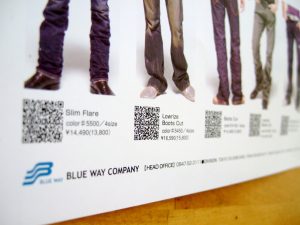QR Codes Induce Progress
Posted on by Timothy Boyle Progress is achieved when people find ways to improve efficiency, decrease costs of goods, free up people’s time or improve experience or product quality. For such progress to occur it is not necessary for said improvement to be as significant the wheel or the internet, instead most progress comes from small incremental improvements, oftentimes from seemingly insignificant technological advances or creations. It is of this latter kind that we see small improvements in progress from the use of a still relatively obscure (at least in the United States) technology: the QR code.
Progress is achieved when people find ways to improve efficiency, decrease costs of goods, free up people’s time or improve experience or product quality. For such progress to occur it is not necessary for said improvement to be as significant the wheel or the internet, instead most progress comes from small incremental improvements, oftentimes from seemingly insignificant technological advances or creations. It is of this latter kind that we see small improvements in progress from the use of a still relatively obscure (at least in the United States) technology: the QR code.
There are daily examples of QR codes being used to increase progress and make the lives of people better off, tiny increments at a time. One interesting example is that of the men’s clothing store ‘Hointer’. Hointer noticed that men have a general antipathy towards shopping and prefer to get in and out as quickly as possible. Hointer’s, in response to this general view of men, found a way to ever so slightly improve the experience of men everywhere with the use of QR codes.
What Hointer did was clearly display a single unit of each men’s pant style in their show room in a way that the customer can decide if they like the style without first having to dig through piles of pants to see the wash, the style, or find the right size. From here—after you have downloaded their app to your smart phone—you simply scan the QR code on the pant(s) style/color you liked, pick a size, and place it in your mobile shopping cart. Once you are ready to try your selection on you click the ‘try on’ button and it tells you which dressing room to go to. Once in the dressing room your pant selections will be waiting for you to try on. If you like them you simply scan the code again and pay for them right there on the app, no waiting in lines, no waiting for a cashier to appear, and almost no time spent ringing you up.
What is so fascinating about this use of QR codes is not that it simply makes the shopping experience slightly better for the shopping male, but that this use of QR codes, in order to improve the customers experience, actually does so much more than this one seemingly little improvement.
First, the QR code improved the shopping experience by saving the customer time. There is less hassle, no searching for your size, no unfolding and folding clothes to see if you like them or not, the shopping experience is made a good chunk of time shorter. This frees up the customer to spend more time shopping somewhere else , more time working, hanging at home or doing whatever, even if it is only a few minutes. Here we see small incremental progress.
Second, we see an increase in efficiency, but not just for the customer who finds his shopping experience easier. We also find that this use of QR codes increases the efficiency of the store owner and store workers. Having such a system means fewer employees are needed to stock shelves, unload boxes, ring up customers and so forth. And for the employees that remain they have far less to worry about and can spend more time helping the customer. Improving the total efficiency and experience of all parties involved.
Last but certainly not least; such increases in efficiency can lead to a reduction in cost to the consumer and the supplier. Due to the increase in efficiency the store now has lower costs since they don’t need as many employees. Such a system also allows the owner to rent a smaller storefront since they do not have all the clothes out on the floor at once, freeing up space for other stores, decreasing demand for commercial space and decreasing (likely in some minimal way) average rents. This increased efficiency allows for much smaller overhead and therefore an increase in profit margin, and as other consumers come into the market and begin using QR codes themselves competition will begin to drive down the costs for consumers, and in turn free up more of their resources to spend on other clothes, other goods or be used to invest or save etc. Ever so slightly driving other future growth.
So here we see the fascinating way in which QR codes are helping to drive progress and make the lives of people better off, even if it is just in some small incremental way.

